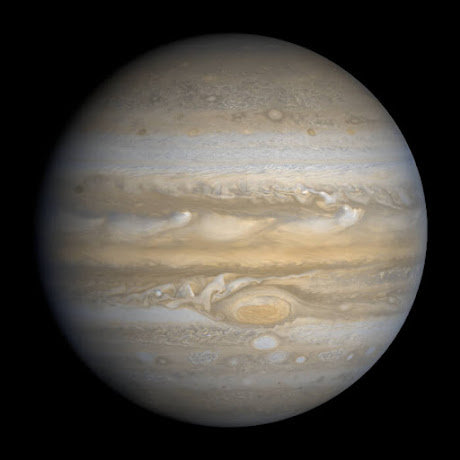Things about Jupiter
What we know about the stormy planet
Introduction:
Jupiter is the fifth planet from the sun and is by far the largest one in the solar system; it is more than twice as massive as all the other planets combined. It can occupy 1300 earths in it. Jupiter is 5.2 astronomical units (778 million kilometers) away from the Sun. Sunlight takes 43 minutes to travel from the sun to this gigantic planet. Jupiter has the smallest day in the solar system: only about 10 hours. It takes Jupiter 12 earth years to complete one revolution around the Sun. Its equator is tilted with respect to its orbital path around the sun by just 3 degrees. This means that Jupiter basically spins upright and doesn't have extreme seasons as other planets do.
The atmosphere:
As a gas giant, Jupiter doesn't have a true surface. The planet is mostly swirling gases and liquids with a dense rocky core of heavier elements. While a spacecraft would have nowhere to land on Jupiter, the extreme pressures and temperatures deep inside the planet would crush and melt the spacecraft trying to fly in. Jupiter's upper atmosphere is about 90% hydrogen and 10% helium by volume. Since helium atoms are more massive than hydrogen, Jupiter's atmosphere is approximately 75% hydrogen and 24% helium by mass, with the remaining one percent consisting of other elements like methane, water vapor, ammonia, and silicon-based compounds. The pressure in its deep interior is so high that hydrogen there exists in a fluid metallic state. This gives Jupiter the largest ocean in the solar system: an ocean made of hydrogen instead of water. Jupiter's stripes and swirls are actually cold, windy clouds of ammonia and water floating in an atmosphere of hydrogen and helium.
Jupiter's appearance is a tapestry of colorful cloud bands and spots. The top cloud is probably made of ammonia, while the middle layer is likely made of ammonium hydrosulfide crystals. The innermost layer may be of water ice and vapor. The vivid colors you see in thick bands across Jupiter may be plumes of sulfur and phosphorous-containing gases rising from the planet's warmer interior.
The Iconic Great Red Spot is a giant storm on Jupiter, bigger than Earth, that has been raging for hundreds of years. More recently, three smaller ovals merged to form the Little Red Spot, about half the size of its larger cousin. Scientists do not yet know if these ovals and planet-circling bands are shallow or deeply rooted in the interior. With no solid surface to slow them down, Jupiter's storms can persist for many years.
The Jovian magnetosphere is the region of space influenced by Jupiter's powerful magnetic field. As the most massive body in the solar system after the sun, the pull of Jupiter's gravity has helped shape the fate of our system. Jupiter's gravity is likely responsible for violently hurling Neptune and Uranus outwards. Jupiter, along with Saturn, may have slung a barrage of debris towards the inner planets early in the solar system's history, which likely caused the existence of the Asteroid Belt.
About its moons:
There are a total of 79 moons revolving around Jupiter: 53 of which are confirmed and 26 provisional moons awaiting confirmation of a discovery. Jupiter also has several rings, but unlike the famous rings of Saturn, Jupiter's rings are very faint and made of dust, not ice. Data from the Galileo spacecraft indicated that Jupiter's ring system may be formed by the dust kicked up as meteoroids smashed into the planet's inner moons. While Jupiter itself is unhospitable, the same is not true for some of its many moons. With 4 large moons and many smaller moons, Jupiter forms a kind of miniature solar system. The four largest moons of Jupiter are called Io, Europa, Ganymede, and Callisto. They were discovered by Galileo Galilei and over the period of time, we've got a lot of information about them.
Ganymede is the largest moon in our solar system, larger than mercury or pluto. The moon has at least one ocean between layers of ice, although it may contain several layers of both ice and water, stacked on top of one another. This moon is the main target of the JUICE spacecraft that's scheduled to launch in 2022.
Io is the most volcanically active in our solar system. The sulfur in its volcano's spew gives Io a blotted yellow-orange appearance. As Io orbits Jupiter, the planet's immense gravity causes "tides" on Io's solid surface that rise 100 meters high and generate enough heat for volcanic activity.
The frozen crust of Europa is made up mostly of water ice, and it may hide a liquid ocean that contains twice as much water as Earth does. Some of this liquid spouts from the surface in the newly spotted plumes at Europa's southern pole. The liquid water ocean may contain the ingredients for life, making it a tempting place to explore.
Callisto's very few small craters indicate a small degree of current surface activity. It has very low reflectivity; this suggests that its surface is may be composed of dark, colorless rocks.





Apt and informative. Amazing!
ReplyDeleteGood article. Nicely done and written. This post will be very helpful for readers. Keep up the good work...
ReplyDeleteGreat job riya! so proud of you
ReplyDeleteCan't wait for your posts about the next planets
Delete